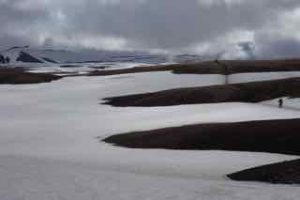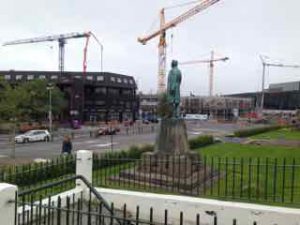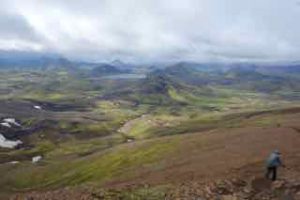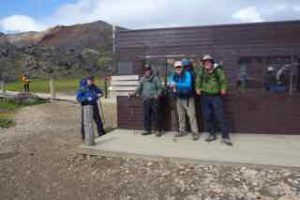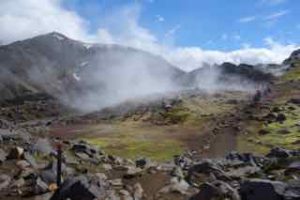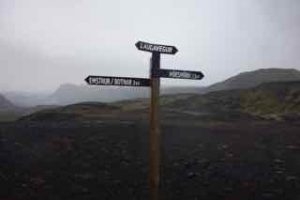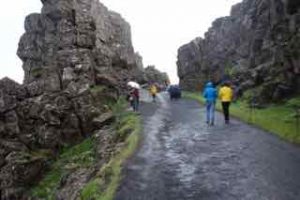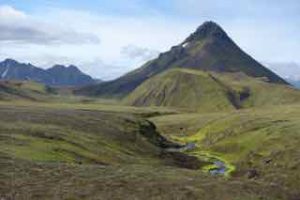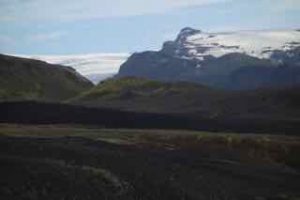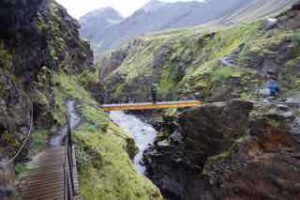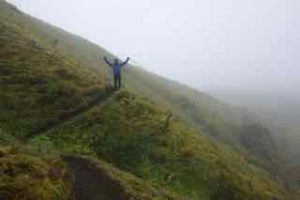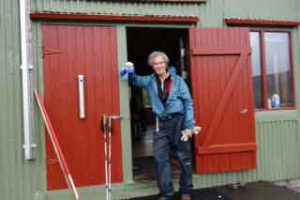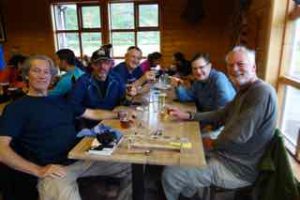Iceland Trek
Posted on January 29, 2018 - Leave a Comment
My Trek in Iceland
The sleet made progress slow. Ahead a white light flickered atop a pole sticking from a pile of rocks. It was a beacon of some sort. Hope flutters in my breast. Maybe it’s the top. Maybe we can trudge through the wind, sleet and snow, but at least do it downhill for a while.
We’ve been climbing all day in full packs, the last few hours through a wilderness of snowfields. At the crest of each slope, we peer into the sleet, looking for the hut where we’ll spend the night. But … nothing. The trail dips and begins another climb. It’s been doing this all afternoon. At the rock pile Jim holds his hiking stick in the air. The wind is blowing. I joined him. He pointed through the sleet. There it was, the hut, our hut, a hundred yards away. Hrafntinnusker, it’s called. Don’t even try to pronounce it. Clear your throat twice while rolling your tongue. Our relief is hard to describe.
The plane touched down in Reykjavik at 6:30 in the morning. Groggy with missed sleep and four hours out of our time zone, we head to the Blue Lagoon. It’s a famous spa, a lake of hot water, heated in the deep fissures of an extinct volcano. The volcano no longer erupts, but heats enough hot water to warm most of Reykjavik. They pipe the hot water through their houses and even under parking lots to melt the snow. Its how they heat the bunkhouse at Hrafntinnusker. There are no fireplaces or propane heaters. Thin metal pipes run from floor to ceiling. It’s a comfortable heat.
It’s a good way to wake up, wading in the mist of Blue Lagoon. A water-side kiosk offers a tub of silica mud – to give the skin that ingenue look. Here we are two hours off the plane, wandering half-awake in a fog of steaming water surrounded by half-naked people painted like Amazonian cannibals. Welcome to Iceland.
We drove on to Reykjavik and found our lodging for the night – although here, close to the Arctic Circle, night is a relative term. It never gets dark. Nine days and not a moment of darkness. It puts you a little off balance. At a quarter to midnight it could be late afternoon.
I wandered through the city. It’s not big, two hundred thousand people maybe. It rises from the harbor up a broad hill. At the top is Hallgrimmkirja, a new and starkly modern church. Its gray pyramidal tower has become the signature of the Reykjavik skyline.
Jim and I dispute whether its a church or a cathedral. We debate this kind of stuff. Its Lutheran, he insists. They don’t do cathedrals. Architecturally, it’s a basilica, like the Vatican, I point out – prideful of the first and very last fact I possess about religious architecture. If it quacks like a duck.
He and I have had this sort of relationship since school, oh, so many years ago. I enjoy the back and forth with Jim. He does not. It irritates him. It is one of my defining traits: the talent for irritating even my friends. But we’ve been doing this for so long, we forgive and forget. For almost forty years he and I, Ken, Phil and Randall have been hiking together. Its a great friendship. I have come to appreciate it more. We can call it a church.
The city is Nordic, which means it’s clean and things runs on time. The transport people said a van would be at our hotel at seven. It was there at the strike of the hour. It’s modern, cosmopolitan, with great restaurants and even a sense of humor. A billboard for one of the older outfitting companies carries the caption “Waiting for summer since 1927”.
The city is also growing, with cranes everywhere stabbing the skyline. But the language is old, a legacy of the early Norwegians who settled the place. Many of the words are unpronounceable. Full of growls and clicks.
The people are polite and considerate. I waited in line in a crowded bakery, in a hurry one morning, and failed to take a number. At the counter, I was embarrassed. The fellow behind me silently handed me his number, stepped back and took another. When I thanked him, he bowed without saying a word.
Iceland is expensive. Presumably much is imported. The prices, once you’ve done the mental currency conversion, are shocking. A basic burger runs something like $25. If I didn’t know my friends better I’d worry it might discourage their alcohol consumption.
The Laugavegur is an internationally popular trekking trail. It’s close to 40 miles long, and runs through some of the world’s most spectacular scenery. The country is an island in the North Atlantic, southeast of Greenland. It is slowly but inexorably being ripped in two by the tectonic forces prying open the Atlantic Ocean.
The volcanic seam that traces the middle of the ocean runs right through Iceland. You can step on the fault blocks where the North American plate and the European plate are pulling in opposite directions.
It’s a land of lava and volcanoes, many of them extinct, a number of them distinctly not. Eyjafjallajokull (unpronounceable unless you can reverse click) erupted in 2010, throwing up enough ash to shut down European air traffic.
From the high points on the trail the distant landscape has a fairy-tale quality. It is no surprise I suppose that they are big on elves and trolls. There are few trees. Everything is draped in a livery of yellow-green moss. It is a heavy frosting dripped across the lava fields, a velour carpet on the farther hillsides, and a veneer of paint on the distant peaks. The landforms are a jumble of old volcano cones, table-top mountains – the curious offspring of sub-glacial volcanic eruptions – and basins sinking as the earth divides.
The trek begins in Landmannalaugar, a half-day’s drive into the interior. It’s a bustling camp. A few small buildings, a field full of tents, and two converted busses, offering sandwiches and potato chips to the trekkers. There is a crowd of day-trippers, heading into the sunny hills.
We are climbing out of a caldera – the collapsed remains of an old volcano. We are entering what they call in Iceland a “high heat area”. The trail threads among steaming, sometimes boiling, pools, fumaroles of stinky gas, and in many places boulders by the side of the trail venting clouds of hydrogen-sulfide – the smell of rotten eggs. It is the smell of magma, the molten rock simmering somewhere below. Here, in Landmannalauger, it is not that far below.
As we climb, the day-crowd disappears. We have full packs, which was not my idea. So the going is a little breathless on the steep sections. By midafternoon we emerge at what feels like the top of the world, a weird landscape of snowfields and dark lava hills. The trail runs from snowpack to lava, back and forth. There is no break from the wind. It is relentless and pelts us with sleet. But the sleet comes and goes, turns to drizzle, peters out, returns and is gone again. This is Icelandic weather. They can be a little snippy about it. What’s the weather, you ask. Look outside, the reply, it’s Iceland.
The climb is more than we expected. I don’t remember anything in the guidebooks about a torturous, unforgiving ascent through wind and sleet. One fellow did mention his exuberance at arriving at Hrafntinnusker. Now I understand. We have made reservations to stay in the bunkhouses – called huts – at Hrafntinnusker, Aftavatn, Ermstrur and Thorsmork. They are sanctuaries from the weather.
The huts are crowded with people mostly from Europe. One couple, a German fellow and his Spanish wife, spoke Spanish. A larger group was French. Another from Spain. But everyone it seems, except the French of course, speaks a little English, particularly the Icelanders, almost all of whom speak it well. For myself, I know enough French to elicit contempt from the French, enough Spanish to elicit pity, and enough Icelandic to prompt uncomprehending stares.
Our corner of the hut, which houses twelve bunks, is our group and the French. No struggling through the snow with packs for these people. They had food shipped in ahead of time and are busy cutting up vegetables and meat for a large pot of soup simmering on a propane stove in a communal kitchen. It appears that what they say of the French, that they live better than we do, is true. They certainly eat better. We paw through our packs for freeze-dried dinners, sip a little bourbon, and try not to envy the French.
The first day was tough and tiring. Aftavatn, the next camp, is not so bad. We spent an hour or so traversing the snowfields, up steep hillsides and down, but eventually began to descend. The sun came out. There’s a river to cross. This is a drill we’ve prepared for. Pull off boots, pull on river shoes. The water was painfully cold. My feet sort of liked it – for a minute or two. And that’s all it takes and we’re across.
The rivers swirl and churn with summer’s glacial melt. Iceland, predictably, has a lot of glaciers and snowpack. At a crest on the trail we spy the looming edge of one of Iceland’s larger glaciers, Myrdalsjokull. It is a sprawling, gleaming snowfield of immeasurable size. It creates a sense of infinity, where the whiteness rises to the sky and dissolves in the distant horizon.
Aftavatn sits by a lake and in fact the name refers to a lake. Descending from the highlands, we can see it blue and serene in the distance. But it’s not serene once we arrive. The wind is ferocious. We watch a couple of campers staking out a tent whose flaps are blowing horizontal.
Our small bunkhouse shares a kitchen with a group of Americans from NOLS – national outdoor leadership something or other. It is a group of Western people who live for the outdoors.
One woman did her qualification test, dropped somewhere in the tundra of northern Sweden. It is an unusual calling to devote your life or at least your free time – they all seem to have day jobs – to mastering life in the wild outdoors. They insist they are not survivalists – it is more than that. Although I don’t think I quite got the hang of it, it sounds like a type of guide training. One fellow was leaving in a few weeks to take a group of devotees sea-kayaking in Croatia.
There are hot showers at Aftavatn. Five bucks for five minutes, or five hundred kronur. The currency sort of works out to moving decimal places. A thousand kronur is something under ten bucks. You can make mistakes. I gathered up a handful of skin care stuff at Blue Lagoon, thinking I was spending 35 dollars, only to find out I had just spent $350. I begged to reverse the transaction. They were very nice. I’m not the only dumb one apparently.
In a cruel trick, the ticket desk for the showers is at one end of the camp; the showers themselves at the other. The blustery wind is cold enough just getting from the bunkhouse to the ticket building. The sprint to the showers completes the freezing process, where we wait in line shivering on a windswept porch, counting the people ahead and multiplying the minutes. Five minutes is barely enough time to thaw.
Aftavatn is a part of the island rift zone. As the plates move apart (what was once poetically called “continental drift“ is now called plate tectonics) forces in the Earth’s mantle fracture the surface causing places like Aftavatn to sink.
The geology is complicated by the volcanism, much of which takes place beneath thick glacial icesheets. Strangely, there are volcanoes which don’t see the light of day, where the heat of molten rock, for a while at least, is matched by the bulk of the ice. The rock created at the meeting of volcanic magma and glacial ice has the technical name of hyaloclastite and is one of Iceland’s unique minerals. Here the icy cold lives cheek to cheek with the super-hot.
If you have curiosity about the way the planet hangs together, there is no place like Iceland. In Thingvellir, the site of the first Icelandic Parliament more than a thousand years ago, a footpath descends between rock walls, which year by year, inch by inch, are pulling away from each other. We are walking, in a sense, between two continents. Where the land is pulling apart, magma – molten rock from the mantle – rises to the surface as lava.
Underground, Iceland is in a state of flux and violence. There are hundreds of earthquakes each year, most too small to notice. The more or less constant jostling of the tectonic plates are continually reworking the faults and fissures, recharging the geysers, replumbing the channels for the deep geothermal water.
Lava defines much of the landscape. There are long stretches of highway running between moss-draped plains of lava rock. The airport is built on a lava plain. Roads are built along ancient lava flows. Many mountains are simply accumulated lava flows left standing after the ravages of Ice Age glaciers.
The hike out of Aftavatn heads straight up Bratthals, the hyaloclastite mountain flanking the lake. It is a sullen uphill slog. After Bratthals, we headed down. Today is a ten-miler. We enter a sunny and picturesque valley. The sun is warm. We take a break at an old shepherd’s shelter. Next to us is the Storasula, the cone of an extinct volcano. Soon we cross the Blafjallakvisl, and then over a sturdy a footbridge over the raging Kaldaklofskvisl.
We are soon heading into a desert – a broad plain of black dirt. Here again is Myrdalsjokull. We see only a glimpse between two mountains but it is otherwordly, a trackless expanse of ice and snow. Beneath the glacier is an active volcano, Katla, which last erupted in 1918.
Emstrur, the next camp, comes into view far below as a cluster of red roofs. The sun is out as we approach, but the sky grows gray and begins spitting rain as we arrive. There is something going on. A vibe of concern. People are talking about the weather. The warden confirms it. “Crazy weather” coming in, she says, waving her hands. It may make the bridge to Thorsmork impassable.
People are beginning to leave. Are they going to Thorsmork? It’s ten miles away. This is hard to make sense of. Its 6:00 in the afternoon. Okay, so it doesn’t get dark, but it still seems a little hysterical. I’ve just hiked ten miles with a backpack. It would just about take an asteroid strike for me to put that pack back on.
My friends and I dismiss the weather scare. We’re Americans, optimistic, practical and just a little lazy. The report is already changing. The front won’t arrive until tomorrow afternoon. The warden concedes that communication isn’t so good here, so the weather report can be taken with some skepticism. We’ll just get up early.
The weather crisis is actually working in our favor. There are fewer people and the hut is no longer crowded. The upper bunks where Randall and Ken and I have scattered out things are almost empty. The bunks are little more than a platform up in the gable with mats laid side by side. There’s plenty of room. It’s also a little darker up here in the windowless garret. Less of the midnight sun. I’ll sleep better.
We’re out by 7:30 and headed to Thorsmork. We cross a gorge. It’s called the Markarfljotgljufur.
I’m not kidding. The stream is wild, pouring through the canyon walls beneath us. To stand on a narrow foot bridge a few feet over a seething river gives you a different perspective. I’m not sure of what, but a sense of the good things in life one might miss.
We drop out of the canyon country into another desert, this one larger than yesterday’s. An endless expanse of monotonous black dirt stretching to distant mountains etched dimly on the horizon. Its hard to photograph. There’s nothing to take a picture of. Which, of course, is the special beauty of it. It’s a nothing like you’ve never seen before, a stark windy plain stretching to low spiky ridges. It could be another planet.
On the first day we saw no vegetation at the high elevations. Too cold and windy. Here, it’s different. The ground is littered with volcanic debris. I pick up a couple of lava pieces to take home. Its not even cold, but there’s barely a tuft of grass.
Ken has reserved a Volcano Hut in Thorsmork. In the trail guide we are given to understand that we are buying into some level of luxury. In fact it’s a simple bunkhouse. It’s small and crowded. But at least it’s just us. No French folk making us feel like American society has lost its way in anomie and commercialism. The weather prediction is about right. Not long after we get in, the rain begins. But there are hot showers and no time limits.
We’re a second day in Thorsmork. It’s rainy, not raining, but rainy in the Icelandic mode of drizzle that turns off and on. Ken, Jim and Phil won’t budge. Randall and I pull on rain gear and head out. I’m delighted just to hike with a daypack. We pick a two hour hike, miss a turn, end up at another hut by a river. We get our bearings and head back out. We stop at Skaggi, a cave memorable for my stumble into a man-size hole in front of Skaggi. I’m hypnotized by the cave and walk right into it. Its full of bushes and roots, more a gentle tumble than a full-scale plunge.
We climb a trail that heads uphill and away from the settlement. Randall, who is the corporate suit in the group, a highly paid tool of some multi-tentacled hydra in New York, is actually the most adventurous. He and I climb a knife-edge of rock overlooking the river. The current has undercut a promontory which juts over the water. We find another path leading who knows where and just follow it. It takes us up and through a welter of low birch groves into a clearing at another promontory. A large pile of rocks announces that this is the end of the trail. Below us and away we see a corner of the Thorsmork camp. We share a bar of something. I adjust my jacket to accommodate the assortment of lava rocks I am compelled to collect.
At dinner Ken announces his retirement. He is a psychiatrist and his group has just sold their building. He’s grown weary of the profession, not so much the hopeless parade of misery he sees each day, but the accelerating bureaucracy of medicine. We toast him with shooters of Bjork, a good Icelandic drink. Skal, as the Icelanders say. Cheers.
